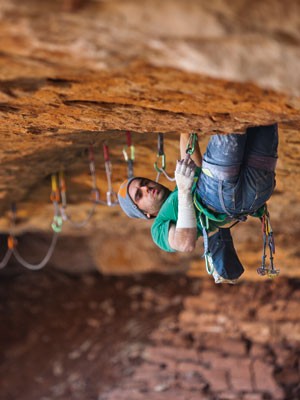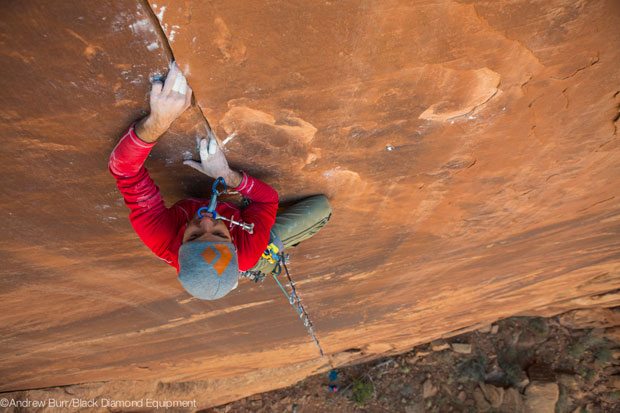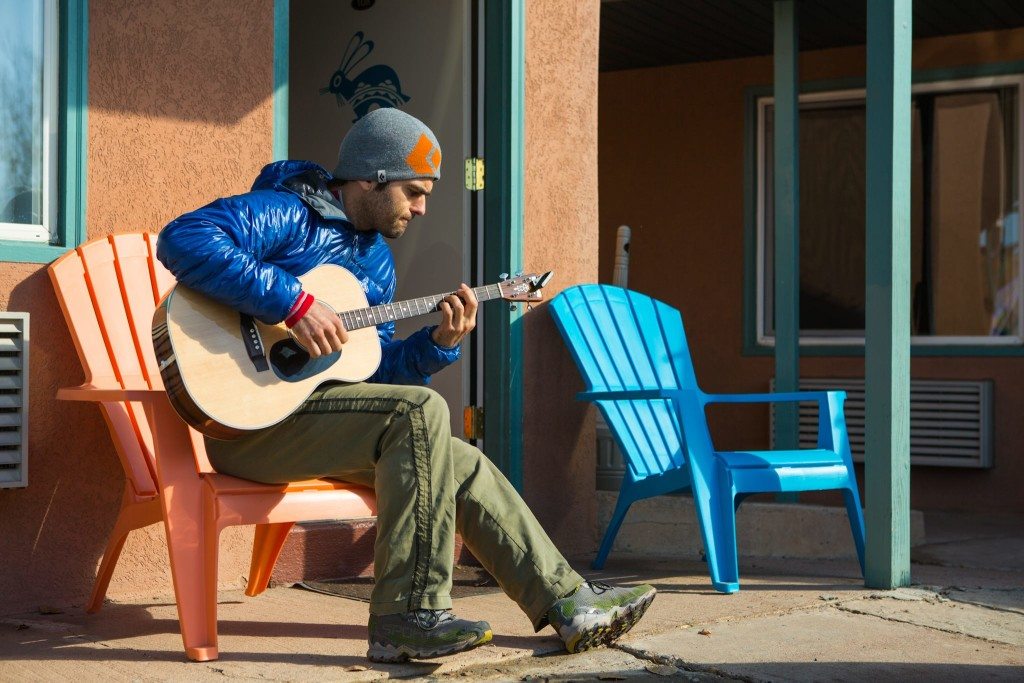Jean-Pierre Ouellet is Addicted to Cracks
In the Belle Province, almost everyone who climbs knows Jean-Pierre 'Peewee' Ouellet. The crack phenom has been on the forefront of hard trad climbing for years, not only at home, but in the States as well. But his tick list goes beyond simply doing hard 5.13 cracks. He also climbs up to 5.14 in sport, boulders double-digits and climbs difficult ice and mixed routes.

The following is an article written by David Savoie in 2012 for Gripped magazine.
How did a kid from a small Quebec town, where there was almost no rock, become a top Canadian crack climber? It involved a lot of planning and a never-ending commitment.We met at his home in Montreal. He was between trips (again) and was shopping for a house up north in the Laurentians. He wants to be closer to good crags – important when your life revolves around climbing.
Climbing is what he does, full-time, and Jean-Pierre Ouellet has been pulling on rock for a while. He was dubbed “Peewee” because of his 5’5″ frame and he now has thick knuckles from years of crack climbing. Even though his boyish look has hardly changed throughout the years, a few gray hairs are now showing. And the 33 year-old says he feels the effects of aging on his body. He’s not recouping as fast as he used to.
Yet he’s not ready to stop. In fact, this may be his best year so far. Among his achievements, his latest tick, Necronomicon, is a 5.13d fist roof crack in Canyonlands National Park. A stamina-fest that the locals couldn’t complete after years of effort – he nailed it in two weeks. For the ascent, Ouellet earned an honorable mention in the 2012 Golden Pitons awards. Then came the Guy Lacelle Spirit Award. The jury estimated Ouellet was to cracks what Lacelle was to ice: a master of the medium and completely committed to a climbing life. “I’m proud of that one. It was really unexpected,” Ouellet says with a smile.
Prizes, great sends and magazine covers have increased his climbing celebrity status. He likes representing Quebec abroad, but would like to live without the attention. In the Belle Province, almost everyone who climbs knows Jean-Pierre ‘Peewee’ Ouellet. The crack phenom has been on the forefront of hard trad climbing for years, not only at home, but in the States as well. But his tick list goes beyond simply doing hard 5.13 cracks. He also climbs up to 5.14 in sport, boulders double-digits and climbs difficult ice and mixed routes.
Is there a secret recipe to climb like him? Does he have good genetics or parents that were athletes? Perhaps his size is the reason why he climbs so hard? The answer is deceptively simple: his performance is the result of hard work, a strong will and a unique outlook on climbing.
“Boy, I’m always telling that story,” he says, sighing. Born and raised in Saint-Marc-du-Lac-Long, a small town in the Temiscouata region, Ouellet first started climbing as a kid. He would venture on chossy slabs outside his home with a yellow plastic cord as a protection, basically soloing crumbly rock. He was already fascinated by the sport and was constantly watching scenes from the movie K2 – he was hooked. Young Ouellet wanted to climb, but the closest gym was in Quebec, three hours away. He kept asking his mother to take him climbing until she eventually gave up and brought him to Saint-André-de-Kamouraska, a rocky band of quartzite where sport climbing was soaring. It was the early 90s, and the sport was still developing in the province. He walked up to the cliff alone, found a handful of climbers and asked them if he could try. He was 14 at the time. It took off from there.

Back then, climbing on gear was the norm and he soon started to plug cams and nuts into cracks. But he didn’t get it at first. “Like everyone else on the east coast, I was getting my butt kicked,” says Ouellet. Teaming up with one of his good friends, Jean-François Beaulieu – owner of Délire Holds – he started to tackle hard lines in Quebec.
This naturally led to Val-David. A stone’s throw away from Montréal, the crag is the birthplace of rock climbing in Québec. It was also a milestone for Ouellet. After doing the local 5.13 roof crack Toit de Ben, he set his sight on La Zebrée. At a grade of 5.14a, La Zebrée was dubbed the hardest crack in the province and perhaps the east coast. This is when he started his epic battle for the second ascent and the first true redpoint.
Ouellet realized he wasn’t strong enough to link this beast – an overhanging finger and hand crack that slices through two roofs. So instead of focusing solely on the route, Ouellet hit the road to find similar lines that would help him build his strength. Roaming through all the biggest trad spots – Yosemite, Moab, Indian Creek – he started ticking 5.12s and 5.13s, always with La Zébrée in mind. He repeated routes like Sphinx Crack 5.13b and Fiddler on the Roof 5.13d, both similar in style to his nemesis back in Quebec.
Peewee found himself sieging La Zébrée for two years, waging a war on conditions. The route suffers from seepage and he would often clean the route for hours in order to give it a try. He was still living in Quebec city and working La Zébrée meant a five hour drive each way. Ouellet finally clipped the chains of in 2007.
For a few years now, Ouellet has been on the hunt for America’s hardest cracks. He’s slowly ticking projects and obscure unrepeated lines. Among them, he nabbed the second ascents of Hot Pork Sundae in Indian Creek and Home on the Range in Vedauwoo, both 5.13c.
“Let me show you something,” he says, reaching for his laptop. In a password protected file he’s been compiling a list of every 5.13 + and harder crack in America. If it’s hard and it’s a crack, it’s in this list. Every once in a while, he’ll remove or add a new line depending on what he finds while browsing through guidebooks or on the Internet. His goal is to do them all – eventually. Of the roughly 60 listed lines, he’s already redpointed half of them, “but I have yet to do the hardest,” Ouellet points out. Cobra Crack, his current project, has resisted all his assaults.
When asked about his natural talent, he cracks a smile. “I’m not naturally good,” he says. “But I have a really good pain tolerance.” Crack climbing in the realm of 5.13 involves torquing hard on your skin. Even with taped hands, the rock tears out chunks of flesh.
But Ouellet is growing tired of cranking hard on short, bouldery lines just for the sake of a list. He wants to go back to what first drew him to climbing: big wall expeditions. He’s already planning stints in Patagonia. “For me, the ideal type of climbing is an all-free route on a big granite wall in an alpine environment. Pakistan, Alaska, Patagonia, Bugaboos, Baffin Island, Greenland.”
It’s a Saturday morning in Vertical. The climbing gym is a few minutes away from Ouellet’s house. When he shows up, only a few climbers are tackling the holds on overhanging walls. Ouellet is prepping for his upcoming trip by bouldering. He says pure power is his weakness, so he has to put more time into that. To say that Ouellet puts a big burden on his body would be a euphemism. He doesn’t seem to know what stopping means. He climbs anywhere from four to six days a week, sometimes training twice a day. Even with an injured knee last year, he kept on hitting the campus board and even biking using only a single clipped pedal.

For most climbers, a route, a boulder or a project is just another piece of rock waiting to be climbed, but not for Ouellet. To him, everything serves a purpose.
“In my mind, everything I do is a form of training for something else in the future,” he says. Hot Pork Sundae , the crack he completed recently was the perfect training for the Salathe Wall in Yosemite, he argues. Sport climbing and bouldering are just a way for him to get fitter for crack climbing. Jokingly, Ouellet says, “I like to tell my friends that training is not the time to have fun.”
Although he says he’s sleeping half of the year in his truck, he’s far from your typical climbing bum. He’s earning a decent salary while being a climbing rep and intends sticking to the job, even if it means cutting on climbing time. Again, it’s all part of a bigger plan. “When you are an athlete at 40, you probably won’t be climbing as hard and you might have to look for a job. If I ever retire from difficult climbing, I’ll have the opportunity to work more,” says Ouellet.
If he could have the same salary and the same autonomy without the exposure, he would. He doesn’t like posing for the camera or being compared. Neither does he like spraying. In fact, regardless of all his accomplishments, he still pays tribute to the climbers that came before him. “It’s important to know who did it before you,” says Ouellet.
Even during his early years of climbing, he would read thoroughly the guidebooks, to get a sense of who where the first ascentionists. His own name is now printed in a few Quebec’s guidebooks as well. His long trips have not prevented him from cleaning, bolting and doing FA’s throughout Québec. It’s part of what he’s giving back to the local climbing scene, his good friend Jean-François Beaulieu argues.
“He’s a positive figure. And his ethics in trad, while respecting other styles, is a model for other climbers. Doing all these cracks has renewed interest in trad climbing and helps protect gear lines from being bolted. He’s an excellent ambassador for the sport,” says Beaulieu.
What does the future hold in store for Ouellet? He hopes to grow old and still climb, doing easier cracks and teaching younger guns. You can be certain it’s all part of the plan. – David Savoie is a climber and writer living in Montreal. Follow Ouellet on Instagram here.



